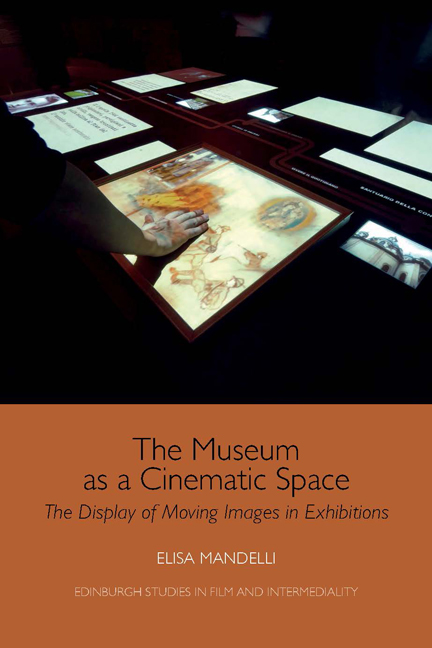Book contents
- Frontmatter
- Contents
- List of Figures
- Acknowledgements
- Preface
- Introduction
- Part I Between History and Modernity: Films in Exhibitions in the Twentieth Century
- Part II The Museum as a Cinematic Space: Museums and Moving Images in the Twenty-first Century
- 5 From the Museum Experience to the Museum as an Experience
- 6 Audio-visuals in Exhibitions
- 7 The Museum and its Spectres
- 8 A Walk through Images
- 9 New Interpretations of the Movie Theatre
- 10 Touching Images
- Conclusions
- Bibliography
- Index
5 - From the Museum Experience to the Museum as an Experience
from Part II - The Museum as a Cinematic Space: Museums and Moving Images in the Twenty-first Century
Published online by Cambridge University Press: 24 October 2019
- Frontmatter
- Contents
- List of Figures
- Acknowledgements
- Preface
- Introduction
- Part I Between History and Modernity: Films in Exhibitions in the Twentieth Century
- Part II The Museum as a Cinematic Space: Museums and Moving Images in the Twenty-first Century
- 5 From the Museum Experience to the Museum as an Experience
- 6 Audio-visuals in Exhibitions
- 7 The Museum and its Spectres
- 8 A Walk through Images
- 9 New Interpretations of the Movie Theatre
- 10 Touching Images
- Conclusions
- Bibliography
- Index
Summary
FROM OBJECTS TO VISITORS: THE VIRTUALISATION OF THE MUSEUM
The last two centuries have seen museums gradually opening to a wider audience. Since the 1960s, the social role of museums has been increasingly questioned – criticising in particular museum elitism and conservatism – while the public has acquired an unprecedented centrality in the institution's activities. Many researches in museum studies maintain that today visitors can no longer be considered as passive recipients; they are, instead subjects capable of actively engaging with the exhibits and with the information provided by the institution, and of discussing and negotiating values and meanings. Thus, the emergence of a new paradigm, alternative to the Modernist one, is now widely acknowledged. Among the scholars who noted this radical transformation of museum institutions, Eilean Hooper-Greenhill uses the term ‘post-museum’ to describe an emerging museum model, which in her view has many positive features, and that she describes as a process or an experience. The post-museum concentrates on the use of objects, rather than on their accumulation, and the exhibition ceases to be the core of museum activities, becoming one among other forms of communication, such as events, discussions, workshops, and performances. The new museum described by Hooper-Greenhill is a venue of exchange where objects are invested with multiple meanings, introducing the possibility of various interpretations and viewpoints, including those of the visitors. As noted by Hooper-Greenhill, such a perspective implies shifting the focus from objects to visitors and their viewing experience: ‘it is generally expected that audiences wish to be much more active and physically involved in museums today. The age of the passive visitor has passed, to be superseded by the age of the active and discriminating “consumer” or “client”.’
History museums fully incarnate this increased attention for the visitor, and offer a privileged point of view to investigate the processes that affect contemporary museology and curatorial practice, as well as the role of moving images in exhibition design. Indeed, the transformations they went through changed dramatically not only the role of the artefacts, but also the display format and the strategies of attribution of meaning. The last decades have seen a marked increase in history museums and memorials devoted to particularly traumatic events of the (even recent) past, and a corresponding influx of visitors.
- Type
- Chapter
- Information
- The Museum as a Cinematic SpaceThe Display of Moving Images in Exhibitions, pp. 73 - 81Publisher: Edinburgh University PressPrint publication year: 2019



